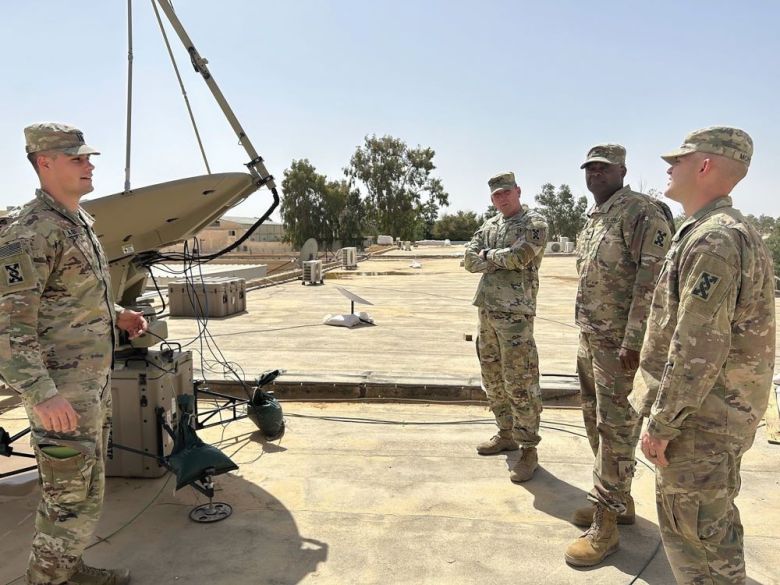The race for connectivity in space is heating up, with private companies launching thousands of satellites to provide global internet access. The United States military aims to harness these new networks in the skies to bolster communications for troops on the ground, ships at sea, and drone aircraft patrolling far-flung regions.
One of the most visible signs of this shift is the growing use of SpaceX’s Starlink low-Earth orbit internet services. About 50 different military commands and Defense Department offices are now using Starlink, said Clare Hopper, director of the Commercial Satellite Communications Office.
Hopper’s office, known as CSCO, is a U.S. Space Force organization that serves as a liaison between private satellite operators and military customers, overseeing nearly $7 billion worth of satcom services contracts across 150 agreements.

While most of those deals still involve traditional geostationary satellites, CSCO is pushing more into newer technologies like low Earth orbit networks. Military satcom buyers are also eyeing emerging capabilities such as small geostationary satellites and direct-to-device satellite connectivity.
“We hope to see more creativity in pricing models and structures,” Hopper tells SpaceNews. “But we also recognize that this is new and can be hard to do.”
The military demand stems from the need to connect troops and weapons systems worldwide as U.S. strategic rivalry with the likes of China and Russia intensifies. Reliable, resilient and secure communications are seen by today’s military as essential for coordination across vast distances.
Low-Earth orbit services
The Defense Information Systems Agency (DISA), a combat support agency of the DoD, manages many of the Pentagon’s commercial satcom contracts in partnership with CSCO. In July, DISA launched the Proliferated Low Earth Orbit (PLEO) Satellite-Based Services contract, the first major opportunity for space companies to propose new offerings tailored to evolving military requirements.
Under the PLEO indefinite-delivery/ indefinite-quantity (IDIQ) contract, space companies will be able to bid on about $900 million worth of military task orders over the next five years. “Once we make a determination of a customer’s needs, we try to help connect them to capability as soon as possible,” said Hopper.
Vendors have until May 31 to submit a menu of products and services for military customers to choose from. “It’s what we call open season,” Hopper said. “It enables contractors to propose new services or new service-level agreements that they think might match customer needs.”
To date, 20 companies have been selected for the IDIQ. The first task order, worth about $70 million, went to SpaceX’s Starlink in September.
Starlink service is now highly sought after by many parts of the DoD and U.S. armed forces. Of the $70 million task order awarded to SpaceX, “we’ve obligated approximately $25 million in funds sourced from about 50 different customers” across the DoD, Hopper added. “We’re seeing a diverse demand for that vehicle, and we’ve been modifying that particular task order seemingly every couple of weeks.”
Hopper noted that the $70 million task order is not a complete reflection of DoD’s entire use of Starlink, as some organizations procure services under other contracts not managed by CSCO.
“We just make sure that we are prepared to meet demand,” she said.

Starlink is the dominant LEO internet provider with the most extensive constellation — with more than 5,200 satellites providing services worldwide as of early January. But DoD is also a customer of LEO satcom provider Eutelsat OneWeb, which has more than 600 satellites in orbit and can now provide global coverage.
Additionally, the military will aim to take advantage of emerging providers as they come online, including Amazon’s Project Kuiper and Telesat Lightspeed. “We expect greater competition and more offerers being able to respond to the needs of the DoD,” Hopper said.
Hopper expects the PLEO contract to be expanded over time. “This will be a continued process,” she said. “We will, over the course of the contract, extend opportunities for industry to update their offerings as well as invite new entrants.”
She said the current contract ceiling of $900 million could be raised if needed. “We are working with DISA on perhaps adjusting that due to demand.”
Small GEOs
Another area CSCO seeks to explore is the use of small geosynchronous communications satellites. The office issued a request for information on small GEO industry capabilities in October, and Hopper said her office “received a really healthy set of responses from industry, and we are working through those now.”
Startups like San Francisco-based Astranis are offering dedicated broadband from small GEO satellites — which are a small fraction of the mass of traditional geostationary satellites. The service is marketed as a nimbler alternative, particularly in geographically challenging or underserved areas.
Hopper said DoD is taking the small GEO industry seriously because it could bring added resiliency to the military’s space architecture, reducing dependence on large GEO satellites.
“Obviously, we will do our due diligence,” Hooper said. “But we’re excited that companies are continuing to take risks and invest in these kinds of novel offerings, especially given the economic climate we’re in now.”
She said that having larger numbers of smaller, maneuverable satellites is attractive to DoD. Military customers want to be able to take advantage of commercial services but also want the flexibility to specify locations and frequency bands based on the particular demands of the operation.
“A DoD customer could effectively enter into an arrangement where they have substantial control and influence over a single satellite that provides the acute coverage that they need,” Hopper said. “So we look forward to making progress with that acquisition, and hopefully getting yet another commercial option established for the department.”
“We do intend to issue an RFP [request for proposals] next year to get that contract vehicle in place,” she said.
Direct-to-cell communications
The Space Force also plans to request information from industry on so-called direct-to-device satellite services provided by companies deploying the equivalent of cell phone towers in space.
“We are very excited about cellular non-terrestrial networks coming online,” Hopper said. The PLEO IDIQ so far includes one provider of direct-to-device services: Falls Church, Virginia-based Lynk Global. “We do anticipate others on-ramping as they enter commercial service.”
Companies in this sector, like AST SpaceMobile in Midland, Texas, “have expressed interest and have met with us saying that they intend to pursue contract vehicles,” said Hopper.

SpaceX is getting in the game as well, and plans to start testing direct-to-cell connectivity between Starlink satellites and T-Mobile smartphones in several locations across the U.S. Six of 21 Starlink satellites that SpaceX launched on Jan. 2 carry modems that can connect directly to consumer smartphones to enable text messaging beyond the reach of terrestrial cell towers.
In November, Viasat, a GEO satellite operator headquartered in Carlsbad, California, announced a partnership with internet-of-things startup Skylo Technologies to offer a direct-to-device service using the Inmarsat L-band satellite constellation (Viasat and London-based Inmarsat merged in 2023).
Hopper said it’s still too early to spell out how DoD would buy these services. “We’re in the market research phase right now,” she said. “In many cases, the basic access to this kind of capability will probably be an add-on to the ordinary cell phone plans that DISA handles for DoD.”
Hybrid networks
Many DoD satcom users are now seeking hybrid multi-orbit satcom systems, or hybrid networks that combine frequency bands and satellites in geostationary, medium and low Earth orbits.
GEO satellites have served the military effectively for decades, with established protocols and equipment in place. Transitioning to new systems presents logistical and budgetary challenges, said Hopper. CSCO is now exploring different business models to acquire hybrid satcom services.
“We are certainly moving in that direction,” she said. “Historically, the preponderance of our contracts have been centralized on the GEO orbit.”
Efforts to tap commercial satcom from other orbits started several years ago, as services like SES’s O3b broadband from satellites in medium Earth orbit came into existence. In November, CSCO extended an agreement originally signed with SES in 2018 to provide O3b satcom services to DoD users for another five years.
As new space networks become operational, CSCO is looking at how it can efficiently acquire services leveraging different orbits and frequencies, Hopper said.
“The business model to enable integrated services probably needs to come into focus a bit more,” she added. “You need to ensure that aggregating services from different orbits is affordable to our users under a single umbrella approach.”
Hopper said the military wants the flexibility of multi-orbit networks, but the challenge is structuring enterprise-level contracts so a large number of users can tap into LEO, MEO and GEO satellites without having to pay full price for separate subscriptions.
“Buying in silos is pricey. We need a model that can integrate the cost of accessing these different orbits in an efficient manner,” she said.
“That’s something that we’ll be taking a close look at as we get further along the acquisition process for these contracts that are coming up for solicitation,” Hopper added.
The Marine Corps, for example, is looking to buy multi-orbit satcom services via an enterprise contract that would support multiple organizations under a fixed-price agreement.
DoD buys satcom that way from Iridium under a straightforward agreement where the government pays for unlimited access for all users. An enterprise contract for multi-orbit services is more complex, Hopper said. “We would have relationships with different companies that provide services with their own kind of unique value propositions.”
By consolidating different networks under a single satcom architecture, military commanders could more easily shift traffic and access capacity based on actual needs rather than contractual limitations. “We don’t want contracts to be a series of plans for full-service pricing for the different systems,” Hopper said. “That doesn’t seem like it would bring a whole lot of value to us.”
“We are seeing some suppliers that are getting really creative with how they are bidding [to provide] services” to the DoD, Hopper said, but she could not share details because the pricing models are proprietary. “The good news is that what these suppliers are bringing to bear is flexibility for us, so users only pay for the service they use. This would make our dollar go further.”
Continued reliance on DISA
Hopper was named chief of CSCO in December 2017, just days after Congress passed legislation mandating the transfer of commercial satcom procurement responsibilities from DISA to the Air Force Space Command, which in December 2019 became the U.S. Space Force.
To this day, however, CSCO continues to rely on DISA for financial, administrative and contracting support, Hopper noted. CSCO currently uses DISA facilities at Fort Meade, Maryland, but plans to establish its own offices under the Space Systems Command’s new Commercial Space Office.
“There’s a lot of interdependencies that have effectively kept DISA in a very important role for us,” Hopper said.
“It’s not unreasonable to think that after six years there would be a complete separation, but there isn’t,” Hopper added. “There wasn’t a full appreciation of the complexity of what is required behind the scenes,” she explained.

Commercial satcom contracts, for example, continue to be financed by a DISA-run working capital fund, a type of account used by DoD agencies to fund purchases of supplies and services. Customers who buy these products and services pay fees that cover the administrative costs of operating such funds.
The Space Force is working to establish its own revolving account, but Congress has yet to appropriate upfront funding to set up and administer the working capital fund. Hopper said she hopes to get these resources approved under the 2025 budget request the White House is due to send to Congress in February.
Budget authority is “a long pole in the tent for us,” Hopper said. If the 2025 proposal gets the green light from Congress, “then we would begin to manage our funding independently of DISA.”
Once the working capital fund is set up, CSCO expects to take over at least 20 of DoD’s 147 active contracts for commercial satcom. The aggregate value of all DoD’s commercial satcom contracts — some extending over 10 years — is about $6.9 billion if all options are exercised.
“As our contracts reach the end of life we are making a determination on whether those should go to Space Systems Command,” Hopper said.
As her office continues to organize as a unit of SSC, Hopper expects the appetite for commercial satcom across DoD will grow.
“We’re seeing very strong demand,” she said. “The industry is really innovating in some cool ways, and I think the commercial industry’s role will remain very much valued and solidified.”
This article first appeared in the January 2024 issue of SpaceNews magazine.
- SEO Powered Content & PR Distribution. Get Amplified Today.
- PlatoData.Network Vertical Generative Ai. Empower Yourself. Access Here.
- PlatoAiStream. Web3 Intelligence. Knowledge Amplified. Access Here.
- PlatoESG. Carbon, CleanTech, Energy, Environment, Solar, Waste Management. Access Here.
- PlatoHealth. Biotech and Clinical Trials Intelligence. Access Here.
- Source: https://spacenews.com/dods-satcom-evolution/



